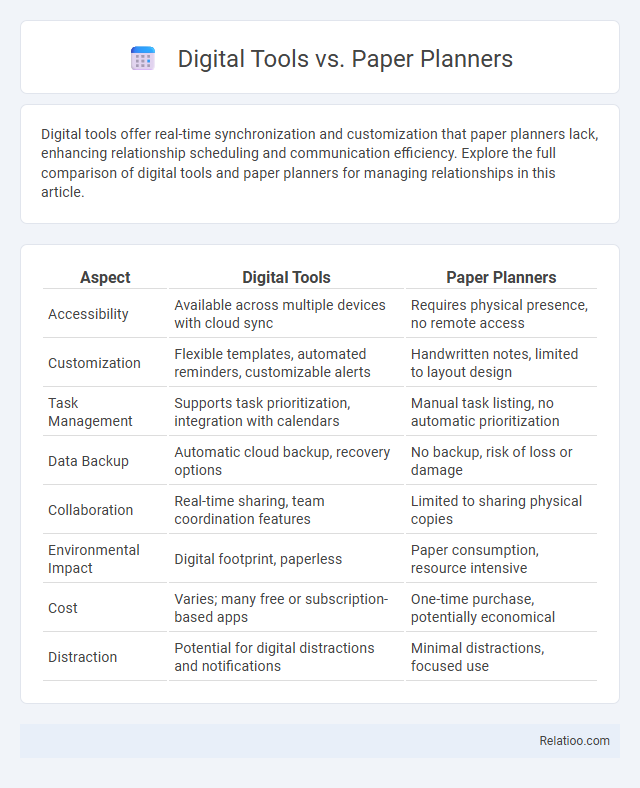Digital tools offer real-time synchronization and customization that paper planners lack, enhancing relationship scheduling and communication efficiency. Explore the full comparison of digital tools and paper planners for managing relationships in this article.
Table of Comparison
| Aspect | Digital Tools | Paper Planners |
|---|---|---|
| Accessibility | Available across multiple devices with cloud sync | Requires physical presence, no remote access |
| Customization | Flexible templates, automated reminders, customizable alerts | Handwritten notes, limited to layout design |
| Task Management | Supports task prioritization, integration with calendars | Manual task listing, no automatic prioritization |
| Data Backup | Automatic cloud backup, recovery options | No backup, risk of loss or damage |
| Collaboration | Real-time sharing, team coordination features | Limited to sharing physical copies |
| Environmental Impact | Digital footprint, paperless | Paper consumption, resource intensive |
| Cost | Varies; many free or subscription-based apps | One-time purchase, potentially economical |
| Distraction | Potential for digital distractions and notifications | Minimal distractions, focused use |
Introduction: Navigating Productivity Choices
Choosing between digital tools and paper planners profoundly impacts your productivity workflow by balancing flexibility with tactile engagement. Digital tools offer seamless integration, real-time updates, and accessibility across multiple devices, enhancing collaboration and efficiency. Paper planners provide a tangible experience that fosters creativity and focus but may face limitations in synchronizing tasks and adapting to dynamic schedules.
The Rise of Digital Tools in Organization
The rise of digital tools in organization has transformed how you manage tasks, offering real-time updates, cloud synchronization, and seamless integration with other applications. Unlike paper planners, digital tools provide customizable reminders, easy access across devices, and advanced search capabilities that enhance productivity and reduce the risk of lost information. Despite these benefits, limitations such as reliance on internet connectivity and data privacy concerns still prompt some users to prefer traditional planning methods for critical or personal scheduling.
Paper Planners: Tradition Meets Tangibility
Paper planners offer a tactile experience that digital tools cannot replicate, providing physical engagement that enhances memory retention and organization. Your ability to customize layouts and add personal touches like handwriting and stickers makes planning more meaningful and visually appealing. Limitations include lack of real-time syncing and search functions, which digital tools handle effortlessly.
Key Features of Digital Tools
Digital tools offer real-time synchronization across devices, customizable templates, and advanced reminder settings that paper planners lack. Your ability to integrate calendars, to-do lists, and note-taking apps in one place enhances productivity and streamlines task management. While paper planners provide tactile benefits, digital tools excel in adaptability and automation, overcoming many limitations of traditional methods.
Benefits of Using Paper Planners
Paper planners offer tangible benefits such as enhanced memory retention and reduced screen time, which improve focus and reduce digital eye strain. Your ability to physically write and organize tasks can boost creativity and personalize goal setting, fostering a deeper connection to your schedule. Unlike digital tools, paper planners eliminate distractions from notifications, making them ideal for maintaining productivity and mindfulness.
Productivity: Digital vs Paper Approaches
Digital tools enhance productivity through real-time synchronization, customizable reminders, and integration with various apps, enabling efficient task management and collaboration. Paper planners offer tactile engagement, reducing digital distractions and fostering memory retention, yet lack automation and quick updating features. Limitations of both approaches include dependency on battery life for digital tools and physical constraints for paper planners, requiring users to select methods aligning with their workflow preferences and task complexity.
Accessibility and Portability Comparison
Digital tools offer unmatched accessibility with cloud syncing and real-time updates accessible on multiple devices, ensuring your plans are always within reach. Paper planners provide a tangible, distraction-free experience but lack the portability and instant access features inherent in digital solutions. Limitations of paper planners include bulkiness and difficulty in sharing, while digital tools may face issues like battery dependency and screen fatigue, impacting your overall planning efficiency.
Customization: Personalizing Your Planning System
Digital tools offer extensive customization options with features like color coding, reminders, and integration across devices, enhancing your planning efficiency. Paper planners provide tactile personalization through handwriting, stickers, and layouts tailored to your unique style, fostering creativity and memory retention. Limitations arise as digital tools may overwhelm with options, while paper planners lack automated updates, making it essential to choose a system that best aligns with your workflow preferences.
Sustainability: Eco-Impact of Digital and Paper
Digital tools significantly reduce paper waste and lower carbon footprints by minimizing the need for physical materials and enabling cloud-based storage, contributing to sustainable productivity. Paper planners, while biodegradable and recyclable, involve resource-intensive manufacturing processes including deforestation and water consumption, impacting ecosystems negatively. Limitations of digital devices such as energy consumption and electronic waste emphasize the importance of balancing eco-friendly practices in both digital and paper-based planning systems for optimal sustainability.
Choosing the Right Planner for Your Lifestyle
Digital tools offer customizable features, real-time synchronization, and accessibility across multiple devices, making them ideal for tech-savvy individuals with dynamic schedules. Paper planners provide tactile engagement, reduced screen time, and enhanced memory retention, appealing to users who prioritize mindfulness and creative expression. Understanding lifestyle demands, such as mobility, task complexity, and preference for analog or digital interaction, is essential in selecting the most effective planning method.

Infographic: Digital Tools vs Paper Planners
 relatioo.com
relatioo.com